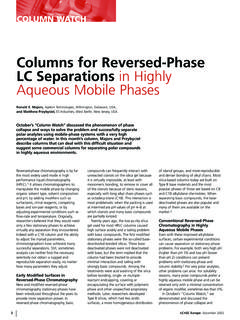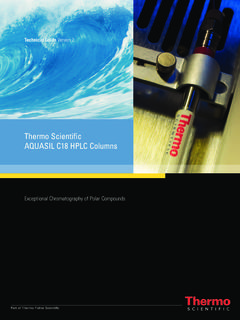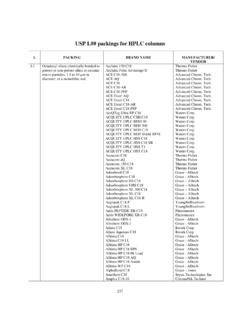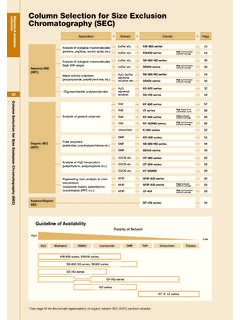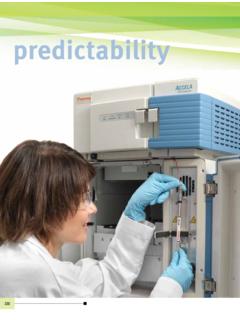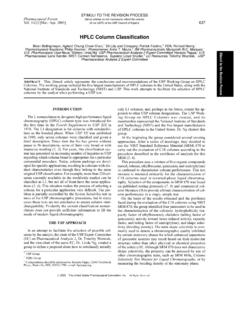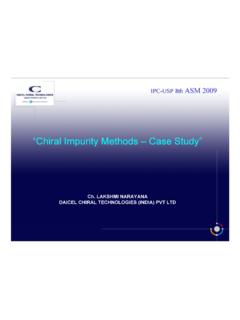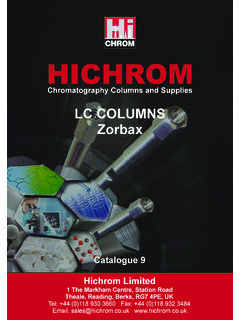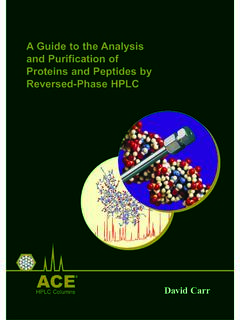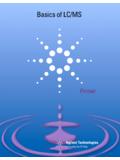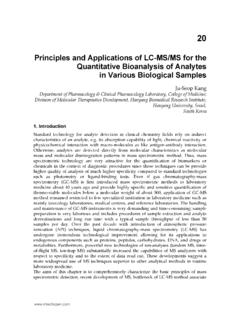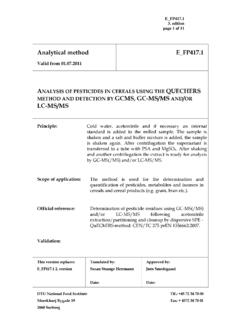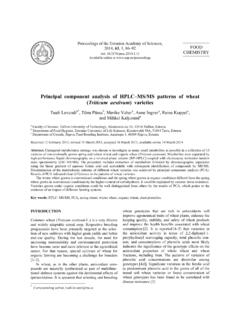Transcription of A Guide to HPLC and LC-MS Buffer Selection
1 HPLC ColumnsJohn DolanA Guide to HPLC and LC-MS Buffer SelectionYour decision has lasting Inert Base-Deactivated HPLC ColumnsFor Performance, Selectivityand Guaranteed ReproducibilityACEperformanceguaranteeIf ACE does not outperform your existing column (of equivalent phase,particle size and dimensions), send in your comparative data within 60days and keep the ACE column FREE OF CHARGE. HPLC of ContentsPageWhy Control pH?2 Practical Implications4 Controlling pH4 What about LC-MS ?6 Just Interested in Low pH?7Or High pH?7 How Much?7 Solubility Issues10 Dilution Effects11 Buffer Preparation12 Precautions13 Summary15 References16 Using Buffers with HPLC and Buffers with HPLC and LC-MSWhen samples contain ionizable compounds, the mobile phase pH can be one ofthe most important variables in the control of retention in a reversed-phase HPLC (RP-HPLC) separation. However, if it is not controlled properly, pH can be a source of many problems.
2 Since most compounds analyzed by RP-HPLC contain one or more acidic or basic functional groups, most mobile phases require pH control. For this reason, buffers are widely used. This booklet highlights some of the important aspects of mobile phase pH for the Control pH?Figure 1 illustrates the need for pH control when ionizable compounds are present. When an acid is more than 2 pH units above or below its pKa, it will be>99% ionized or non-ionized, respectively. Bases are ionized below their pKaandnon-ionized above their pKa. The non-ionized form will be less polar (morehydrophobic), and thus more strongly retained in a reversed-phase system. Thus,at low pH, acids will be more retained (Fig. 1a), whereas bases will be moreretained at high pH (Fig. 1b). If the mobile phase pH is near the pKa, you can see that small changes in pH canmake large changes in retention not what is desired for a robust separation.
3 This is illustrated in Figure 2a, which shows the extreme sensitivity of some compounds to very small changes in pH. Here the resolution changes by a factor of two for a change of only pH units this is the amount of error in pHadjustment common to many laboratories. Figure 2b represents a plot of retention vs. pH for an acid, a base and a neutral compound. At pH 5, retention is less sensitive to pH than it is at pH 3 (for the acid) or pH 6 for the base. Figure 1. Retention vs. pH for a hypothetical acid (a) and base (b). the instability of retention times when the pH is near the pKa, relativepeak spacing (selectivity) can change if compounds of similar structure are present. Another factor that should be considered when choosing the mobile phase pH isthe stability of the column. As a general rule, silica-based columns should beoperated at 2<pH<8. At pH<2, bonded phase loss due to hydrolysis can pH 8, the silica backbone becomes increasingly soluble.
4 Higher-purity silica tends to tolerate high pH better than lower-purity products. A further complicating matter is the potential for ionization of unbonded silanol (-Si-OH)groups on the surface of the silica particle. For older, less-pure silica (oftenreferred to as Type-A silica), the pKaof these silanol groups is in the pH 4-5region. This means that at pH>6, significant silanol ionization can occur for thesematerials. Historically, this has been the major cause of peak tailing for basiccompounds through cation exchange processes. The newer, high-purity ( Type-B ) silica has a pKa>7, so peak tailing due to cation exchange with ionized silanol sites is minimal. This is one reason why high-purity silicas givemuch better peak shape for bases than their older counterparts, as is illustrateddramatically for several basic components in the separations shown in Figure 3. In addition to peak shape improvement, the use of high purity silica leads toimproved reproducibility compared to low purity silica due to the reduction ofthese unpredictable secondary silanol 2.
5 The effect of small changes in mobile phase pH on the separation.(a) Basic analytes: p-anisidine, m-toluidine, 4-chloroaniline, 3-aminobenzonitrile (inretention order); 27:73 methanol/phosphate Buffer .(b) Acid: salicylic acid; base: methylamphetamine; neutral: phenacetin. (a)(b) ImplicationsThe characteristics of the column and of samples in general, lead to a recommendation to start method development with a mobile phase in the pH 2-3range. At this pH, the ionization of most organic acids will be suppressed, as will the ionization of any silanol groups on the column. Bases will be ionizedunder these conditions, but the pKaof most basic compounds is >7, so operatingat a sufficiently high pH to suppress ionization will be detrimental to mostcolumns. So, all other things being equal, it is best to start out at a low pH. If you need to operate the column at a high pH, be sure to select a column known to be stable in the pH region you low-pH ion suppression does not provide acceptable results, the mobile phasepH can be adjusted to help obtain the desirable separation.
6 It usually is most fruitful to adjust the mobile phase organic content (%B-solvent) to obtain acceptable retention for neutral and non-ionized compounds, then to adjust the pH to fine-tune retention of ionic pHSince the retention of ionizable compounds is very sensitive to the mobile phasepH, it is necessary to control the pH of the mobile phase by the addition of abuffer. A Buffer maintains the pH when a small amount of acid or base is different substances have been used for buffering in HPLC; some of theseFigure 3. The effectiveness of high purity silica in reduction of silanol tailing of : norephedrine, nortriptyline, toluene (neutral), imipramine, : 250 x , 5 m columns; 80:20 methanol/25 mM phosphate (pH ); are listed in Table 1. A Buffer is most effective when used within 1 pHunit of its pKa, but may provide adequate buffering 2 pH units from the pKa. Table of Common Mobile Phase Additives1 The most popular buffers for HPLC with UV detection are phosphate and acetate.
7 Phosphate and acetate are particularly useful buffers because they can be used at wavelengths below 220 nm. As can be seen from Table 2, phosphatehas three pKavalues that give it three buffering ranges: <pH< , <pH< , and <pH< (allowing for buffering of pKa 1 pH units).Practical limits of column stability require that we truncate the lower range <pH< and eliminate the highest range. Notice that there is a gap in buffering between pH and pH for phosphate. This means that, although it is possible to adjust the pH of phosphate to , there is negligible bufferingcapacity at this pH. To fill this buffering gap, another Buffer is , acetate fills this need well, with a buffering range of <pH< a slight extension of the buffering range from 1 pH units from the pKa,phosphate and acetate can cover the entire pH range of 2<pH<8 normally used forsilica-based (25 C) acid (pK1) acid (pK1) acid (pK2) acid (pK1) acid (pK3) acid (pK2) (pK2) acid (pK2) acid (pK3)1data of [1]; 2 Merck Index; 3 CRC Handbookof Chemistry and Physics during method development, you may desire to have full control ofthe pH over the useful range of the column.
8 In this case, a blend of phosphate and acetate Buffer will allow continuous variation of the mobile phase from2<pH<8. Once you find the desired pH, the Buffer not needed can be example, if the final mobile phase pH is , acetate is all that is needed, sophosphate does not need to be used at analysts like to use citrate for a Buffer , because it has three overlapping pKavalues that allow buffering over the <pH< range (Table 2). However,citrate does not have as low a UV-cutoff as acetate and phosphate, so work atwavelengths below 220 nm is not possible; in addition, some analysts find thatthey have more problems with check valves when citrate is used. So citrate Buffer usually is a second choice to phosphate and 2. Common HPLC BuffersWhat about LC-MS ?When a mass spectrometer is used as the LC detector ( LC-MS ), the mobile phase must be volatile, because one of the functions of the LC-MS interface is tovaporize the mobile phase.
9 This means that the most popular Buffer for LC-UVwork, phosphate, cannot be used. Ammonium acetate is sufficiently volatile forLC-MS use, but we are left with the <pH< and <pH< range to cover. Table 2 lists several additional buffers that are sufficiently volatile for LC-MS use. Ammonium formate ( <pH< ) does a fairly good job of filling bufferpH rangeLC-MS compatiblephosphate (pK1) (pK2) (pK3) (pK1) (pK2) (pK3) acid ( ) acid ( ) acid ( ) for LC-MS as ammonium acetate gap at the low-pH end. Ammonium bicarbonate ( <pH< ) works for higher pH values. These do not completely cover the desired buffering ranges, but for LC-MS applications they are what are available to work Interested in Low pH?If a low-pH mobile phase is all that is important, v/v phosphoric acid (Table 2) provides reasonable buffering at pH 2 for LC-UV acid (TFA) also generates a mobile phase pH of 2 at v/v(Table 2), and for many years was the additive of choice for LC-MS at low also acts as an ion-pairing reagent, and is widely used for protein and peptide separations.
10 TFA, however, can suppress ionization in the LC-MS interface, causing a drop in signal, so it has fallen out of favour in recent , formic acid (pH , Table 2) is the first choice for LC-MS at low pH. With the use of an acid for low-pH, it is assumed that the pH is moreimportant than the buffering capability if true buffering is needed, select abuffer from Table 2 that encompasses the desired High pH?As mentioned earlier, the solubility of silica increases as the mobile phase pH isincreased above pH 8, so pH>8 generally is not recommended. However, it maybe necessary to work with higher-pH mobile phases in order to obtain the desired separation. In such cases, you should select a column designed for workat high pH. As a general rule, high purity silica, high carbon load and endcapping reduce silica solubility. Phosphate Buffer should be avoided, because it enhances silica dissolution at high pH.
